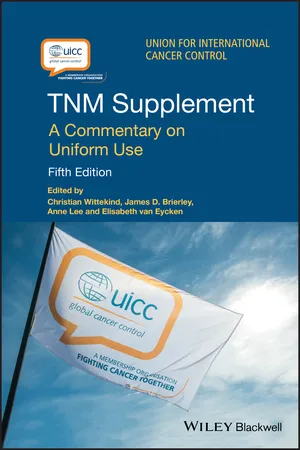
TNM Supplement
A Commentary on Uniform Use
- English
- ePUB (mobile friendly)
- Available on iOS & Android
TNM Supplement
A Commentary on Uniform Use
About this book
The Union for International Cancer Controls (UICC) TNM classification system is the most widely used cancer classification and staging system in the world. It is used to describe the anatomical extent of disease and it is essential to patient care, research and cancer control.
This fifth edition of the TNM Supplement: A Commentary of Uniform Use offers practitioners a wealth of material intended to complement the systems day-to-day use. The volume features:
- Updated definitions of terms used in cancer staging.
- New sections on carcinomas of the thymus, sarcomas of the spine and pelvis and soft tissue sarcomas of the head and neck, and comprehensive updates to the head and neck carcinomas, carcinomas of the lung and neuroendocrine tumours sections.
- Frequently asked questions from the UICC helpdesk.
The Supplement may be treated as a companion text to the recent eighth edition of the TNM Classification of Malignant Tumours (978-1-119-26357-9), supporting the correct and uniform application of the TNM classification system. The TNM Supplement can also be utilised as a standalone book, providing explanations and examples to answer many questions that arise during the daily use of the TNM cancer classification and staging system, particularly in unusual cases.
Frequently asked questions
- Essential is ideal for learners and professionals who enjoy exploring a wide range of subjects. Access the Essential Library with 800,000+ trusted titles and best-sellers across business, personal growth, and the humanities. Includes unlimited reading time and Standard Read Aloud voice.
- Complete: Perfect for advanced learners and researchers needing full, unrestricted access. Unlock 1.4M+ books across hundreds of subjects, including academic and specialized titles. The Complete Plan also includes advanced features like Premium Read Aloud and Research Assistant.
Please note we cannot support devices running on iOS 13 and Android 7 or earlier. Learn more about using the app.
Information
CHAPTER 1
EXPLANATORY NOTES – GENERAL
The General Rules of the TNM System
General Rule No. 1
Examples
General Rule No. 2 (Table 1.1)
Definitions
|
- Clinical classification: the pre‐treatment clinical classification designated TNM (or cTNM) is used to select and evaluate therapy. This is based on evidence acquired before treatment. Such evidence is based on physical examination, imaging, endoscopy, biopsy, surgical exploration and other relevant examinations.
- Pathological classification: the post‐surgical histopathological classification, designated pTNM, is used to guide adjuvant therapy and provides additional data to estimate prognosis and calculate end results. This is based on evidence acquired before treatment, supplemented or modified by additional evidence acquired from surgery and from pathological examination.
Example
Table of contents
- COVER
- TABLE OF CONTENTS
- PREFACE
- ORGANIZATIONS ASSOCIATED WITH THE TNM SYSTEM
- NATIONAL COMMITTEES
- ACKNOWLEDGEMENTS
- ABBREVIATIONS
- CHAPTER 1: EXPLANATORY NOTES – GENERAL
- CHAPTER 2: EXPLANATORY NOTES – SPECIFIC ANATOMICAL SITES
- CHAPTER 3: SITE‐SPECIFIC REQUIREMENTS FOR pT AND pN
- CHAPTER 4: NEW TNM CLASSIFICATIONS RECOMMENDED FOR TESTING AND OTHER CLASSIFICATIONS
- CHAPTER 5: OPTIONAL PROPOSALS FOR TESTING NEW SUBCATEGORIES OF TNM
- CHAPTER 6: FREQUENTLY ASKED QUESTIONS
- INDEX
- SUPPLEMENTAL IMAGES
- END USER LICENSE AGREEMENT